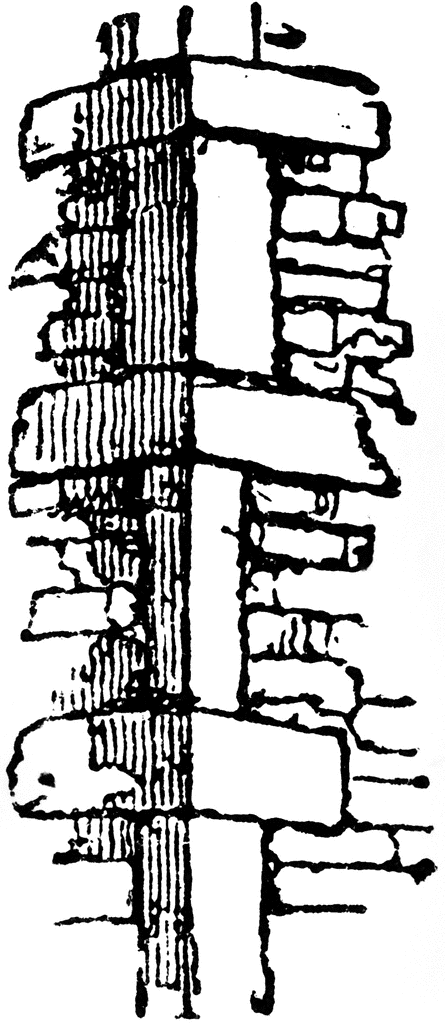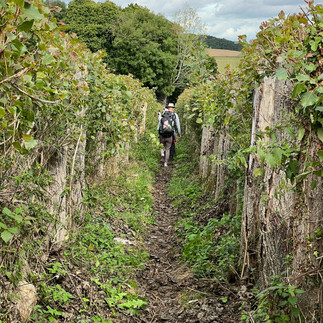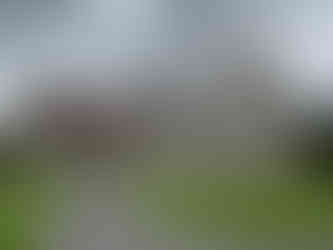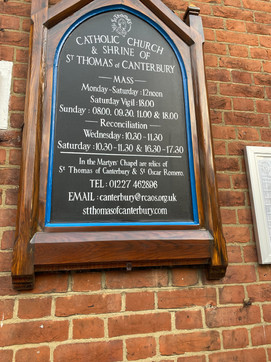We awoke to a beautiful sunrise over the cricket green in Boughton Lees. Cricket has been played on the village green, “The Lees”, for over 200 years. During breakfast at the Flying Horse, as we began our last hiking day, we reflected on how we have grown spiritually, physically, and as a team. We enjoyed speaking with Lisa, our hostess, who was kind and personable, and we gave her a chaplet for her excellent service.

Sunrise on the cricket green of Boughton Lees.
(1) Left: A hearty breakfast at The Flying Horse. (2) Right: Frans giving Lisa a chaplet. Note the dried hops used as décor on the rafters in the background.
We said goodbye to the Flying Horse and Boughton Lees and began the final hike of our pilgrimage. The temperature was 53 degrees and sunny skies--perfect hiking weather!

Leaving the Flying Horse.
(1) Left: Heading out for the trail. (2) Right: Back on the Pilgrims' Way.

We headed towards “Boughton Aluph”, a small town about a mile away. The word “Boughton” means “town where beech trees grow”.
Our stop here was All Saints Church. There has been a church on this site at least since Saxon times, probably of wooden construction. The stone and flint north chapel was built by Alulphus of Boctune ("Aluph" comes from his name) around 1210. The chancel and nave were added in stages and completed by the middle of the following century. The church has undergone extensive restorations, and the renovations are ongoing to this day.
(1) Left: Exterior of All Saints Church in Boughton Aluph. (2) Right: Inside All Saints.
One interesting note about All Saints Church: The church possesses one of the historic “vinegar” bibles published by John Baskett in 1717 (now stored in the Canterbury Cathedral Archives and Library). Vinegar bibles contain a major typo in Luke chapter 20: the Parable of the Vineyard is printed as “The Parable of the Vinegar”. You can read about John Baskett and his "baskett-ful of errors" in bible printing here.
Our next stop was St. Lawrence the Martyr Church in Godmersham. Godmer is an Old English name meaning "good fame" (god = good, maer = famous). Godmersham means "Godmer's homestead." The Domesday book, compiled in 1086, provides this straight-to-the-point entry about Godmersham: Ibi ecclesia (" a church [is] there"). This shows that there was a church standing in Godmersham before 1086, and there is a strong possibility that the church was built by the Saxons, as the “long and short” stonework of the Saxon period is present on the quoins of the church tower.
(1) Left: Exterior of St. Lawrence the Martyr Church, Godmersham. (2) Right: Example of Saxon Period short and long stonework. You can identify this pattern on the exterior quoin (corner) of St. Lawrence in the middle of the picture above (look at the corner behind the cross monument).
(1) Left: Interior of St. Lawrence. (2) Right: The church is home to five bells. The bell pulls are exposed in the church! In most churches, the pulls are not readily seen by churchgoers because they are sectioned off by an upper floor of the bell tower.
The traditional style of pulling full-circle church bells is called "change ringing," and it is a centuries-old craft as well as a highly mathematical activity with a long and rich history. Change ringing was first developed in the early 17th century in English churches, and what makes it unique is how the bells are rung according to mathematical permutations.
Here is a fascinating video on the mathematics of change ringing:
And here is a video from the University of Chicago about change ringing:
If you're interested in learning even more about this topic, check out The Craft of Bellringing, an insightful documentary about the history and practice of British bell ringing. Full documentary here.
Continuing our journey, we walked along many (named) hills . . .
. . . and a variety of paths. Note the apple orchard in the last picture laden with an overabundance of apples!


We arrived in the picturesque town of Chilham and passed by the impressive Chilham Castle. Originally built in 1616 by Sir Dudley Digges on the site of a medieval castle, the house has been lovingly restored by its current owners, including beautiful well-maintained gardens. The estate has changed hands many times throughout the centuries, and additions and alterations to the manor have occurred as well. You can view the chain of ownership of the estate here.
At right: The side of Chilham Castle, viewed from the footpath. Note the vineyard rows and the massive stepped topiaries.
It was interesting for Frans to see that the Hardy Family owned the property between 1861-1918, as his grandfather was William Hardy.
(1) Left: Entrance to Chilham Castle. (2) Right: Chilham Castle.
Chilham is a quaint town with lovely homes. It’s been used several times as a backdrop in films and television programs, for good reason!
In the town of Chilham.

In front of an oak-carved statue of two pilgrims in Chilham. The statue is entitled "Pilgrim Milestone" and was carved by local chainsaw-sculptor Steven Andrews.
We had lunch at the White Horse, a traditional village pub standing in Chilham’s village square. We especially enjoyed our meal here, as it was accompanied by live music, and we loved browsing the books on the shelves along the walls.

Leslie at the White Horse.
Video at right: Entering the pub. Music provided by two members of the Chartham String Band. Note again the dried hops used as décor hanging from the rafters. Also, the chess pieces are figures from the Lord of the Rings.
From left: (1) Lisa ready to order! (2) Frans ordered a Scotch egg. (3) Harry points to an inspirational book (The Canterbury Tales).
Among the books, Harry discovered a wonderfully illustrated book about the Domesday Book, the medieval record of nearly the entire country of England compiled in 1086 under the order of William the Conqueror. One of the purposes of this compilation was so that William would have an accurate assessment of all of his holdings for collecting taxes. Harry found a reference to the town of Oldland (his last name). Known in Old English as “Aldelande”, it was listed as a “town with much new housing”. Osbern Giffard, one of the knights who invaded England under William the Conqueror was listed as having the land holdings. It is a tribute to English continuity that almost all of the Domesday settlements still exist in one form or another.
From left: (1) The taxman cometh: a book about the Domesday Book. (2,3) The entry on the town of Oldland.
Before leaving Chilham, we visited St. Mary Church. The church contains many beautiful stained glass windows and several monuments and memorials to the families of the owners of Chilham Castle and other prominent local families.
(1) Left: Outside St. Mary Church, Chilham. (2) Right: Interior of the church looking towards the rear.
(1) Left: Five beautiful stained-glass windows in a side chapel depicting the last days of Christ on earth: the Agony in the Garden, the Way of the Cross, the Crucifixion, the Resurrection, and the Ascension. (2) Right: A touching memorial to the Hardy children, Arthur and John, who died in 1858 (their family owned Chilham Castle at one time). At the children's feet lie a carved battledore (a kind of racket) and a shuttlecock, making this the only known example in England of a church monument depicting children's toys.
After Chilham, we continued on our journey, relishing the lovely English countryside.

And then, suddenly, we saw the spires of Canterbury Cathedral in the distance. We were in Canterbury! Oh, happy day! We all felt a sense of joy and accomplishment that we made it. Our 152-mile hike has been a rewarding journey filled with physical challenges but spiritual joy.
(1) Left: We arrive in Canterbury. The cathedral rises in the distance. (2) Right: Four happy pilgrims!
Arriving at our comfortable row house accommodations, we quickly cleaned up and walked to the Catholic Church and Shrine of St. Thomas of Canterbury. The Church was opened in 1875, and it is a fine example of Gothic Revival style architecture. Behind the High Altar are two reliefs, one depicting the martyrdom of St. Thomas and the other showing King Henry II performing public penance. This is the only Roman Catholic church in Canterbury, built on the site of a medieval church (demolished in 1870 - but the old St Mary Magdalen Tower was retained).
The Roman Catholic Church and Shrine of St. Thomas of Canterbury.
(1) Left: In front of the church. (2) Right: Beautiful interior of the church.
We attended 6pm mass at the church, and afterward Canon Father Anthony asked us if we would like to visit the Martyrs Chapel. We were delighted that he gave us a personal tour. The red altar cloth and drapery behind the altar evoked sacrifice and martyrdom, reminding us of the red vestments that are worn by the priest on the feast days of martyrs. The heraldic shield on the face of the altar cloth shows three Cornish choughs (in Britain, pronounced “chuffs”), birds of the crow family with their unusual red bills and feet. Becket’s death happened 30 to 45 years before the advent of systematized heraldry, but according to the long-standing tradition of attributing coats of arms to great persons after death, this coat of arms may have been devised for him.
(1) Left: Altar in the Martyrs Chapel. (2) Right: Coat of arms with three Cornish choughs.
Father opened a black reliquary behind the altar and showed us a relic of St. Thomas, a finger bone. In 1220, several cardinals from Rome who were present at the translation of the body of St. Thomas Becket from the crypt to the main floor of Canterbury Cathedral took several small relics of the saint with them. In the past two centuries some of these relics have been returned to Canterbury. Father told us that the pedigree of the relic is well authenticated, having come from the Prior of Chevetogne Abbey, Belgium, Fr. Thomas Becquet, a descendant of the family of the martyr.
(1) Left: St. Thomas Becket reliquary. (2) Right: Relic of St. Thomas Becket.
Father Anthony also gave us a pilgrim blessing at the end of our visit. We were touched by his kindness and humbled by the sacrifice of St. Thomas. It was a blessed moment for all of us.

Canon Father Anthony talks to us about the relic.
Afterwards, we ate at the Citi Terrace restaurant and celebrated our pilgrimage accomplishment with many toasts and lots of good cheer.

Toasting pilgrimage friendship!

















































































コメント